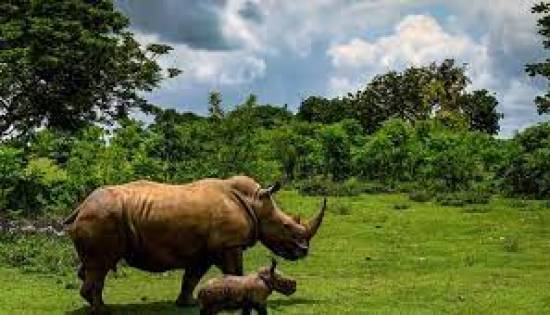Conservation groups say the rate of rhinoceros poaching in Africa has dropped significantly since a peak in 2015.
The latest figures on the animal whose horns are coveted in traditional Chinese medicine are recorded in a report by the International Union for Conservation of Nature (IUCN) and the NGO Traffic.
The report covers 2018 through 2021. It notes an increase in the number of rare black rhinos by just over 12 percent from 5,495 to 6,195; however, it says the number of white rhinos fell from just over 18,000 to 15,942. That's also a change of 12 percent.
The report says overall there was a decrease, with about 22,137 rhinos, black and white, left in Africa at the end of 2021.
IUCN Rhino expert Sam Ferreira says the reason they aren't seeing the results of a decreased poaching rate yet is that the drop needs to be sustained over a longer period.
Ferreira says he believes it wasn't, as some experts have suggested, the COVID-19 lockdowns that made the difference, but improved policing and community involvement.
"I think that what is really important is that the arrests decreased from 493 in 2018 to 279 in 2021," Ferreira said. "Now again, we don't know what exactly is sitting behind these things. But it does suggest that there are interventions, critical interventions that range states and particularly managers on the ground are doing that are having some consequences on the decisions that people make to poach or not to poach rhinos."
The IUCN Traffic report says since 2018, several education campaigns have been delivered to more than one million people.
The WWF's global practice leader, Margaret Kinnaird, says conservationists use everything from social media to classic campaigns with posters to educate the public.
"For WWF, we've worked a lot with Chinese travelers in particular that are going overseas where they are visiting markets that have, for example, elephant ivory and rhino horn potentially for sale," Kinnaird said. "The point there is to change the hearts and minds of those people who are approaching markets and thinking about taking a gift home. Or thinking about buying something for a medical cure. And just giving them alternative ideas for the sort of gift or product they would take home."
Kinnaird says the smuggled horns go primarily to Asia and are sold through illegal markets in the Mekong region and in China, particularly in markets in Cambodia, Myanmar and Vietnam.
She says the horns are marketed from all four of the major rhino range states, the most coming from South Africa but also Kenya, Namibia and Zimbabwe. South Africa accounts for 90% of all reported poaching on the continent, mostly of white rhinos.
Kinnaird says that, while it is good news that poaching rates have dropped, more needs to be done to ensure the animal doesn't become extinct.
"We need to improve our crime-related intelligence and make sure we're targeting the right people, not the little people on the ground, we need to get at the big bosses, the kingpins, the organized criminals," Kinnaird said./VOA


